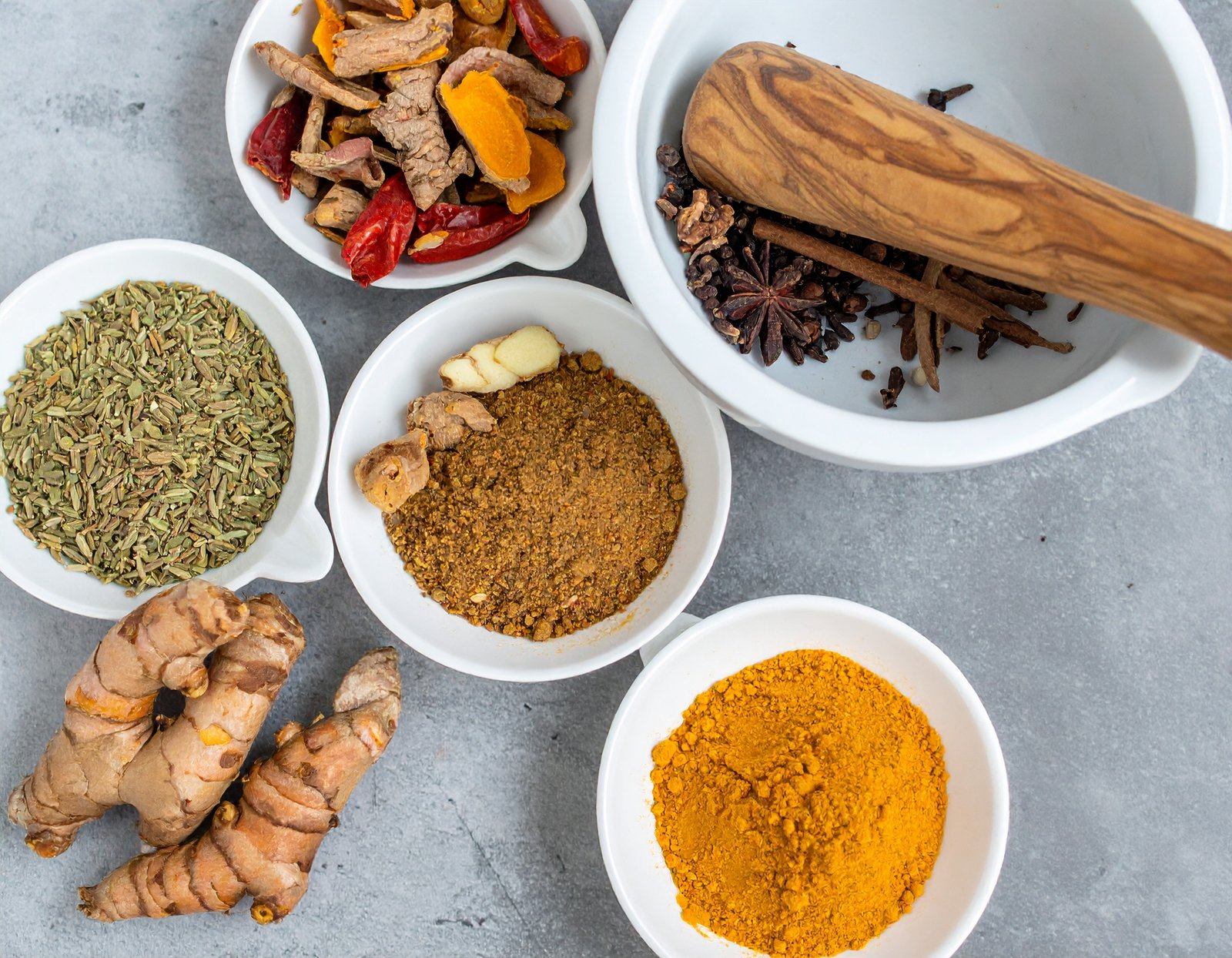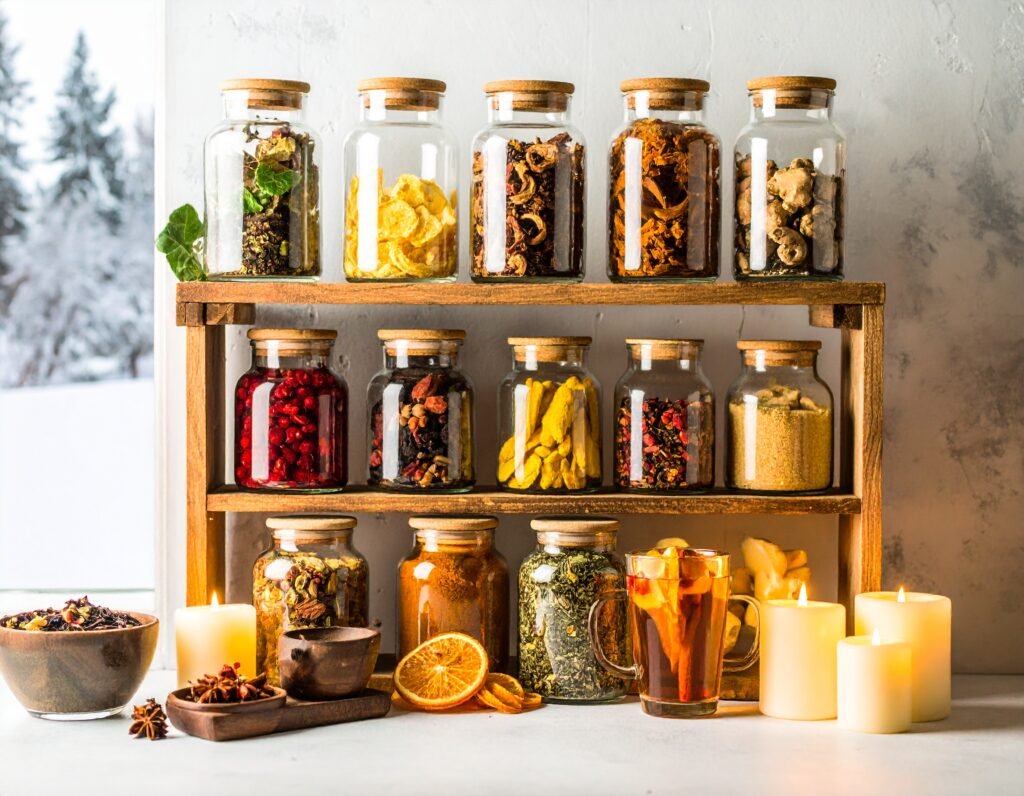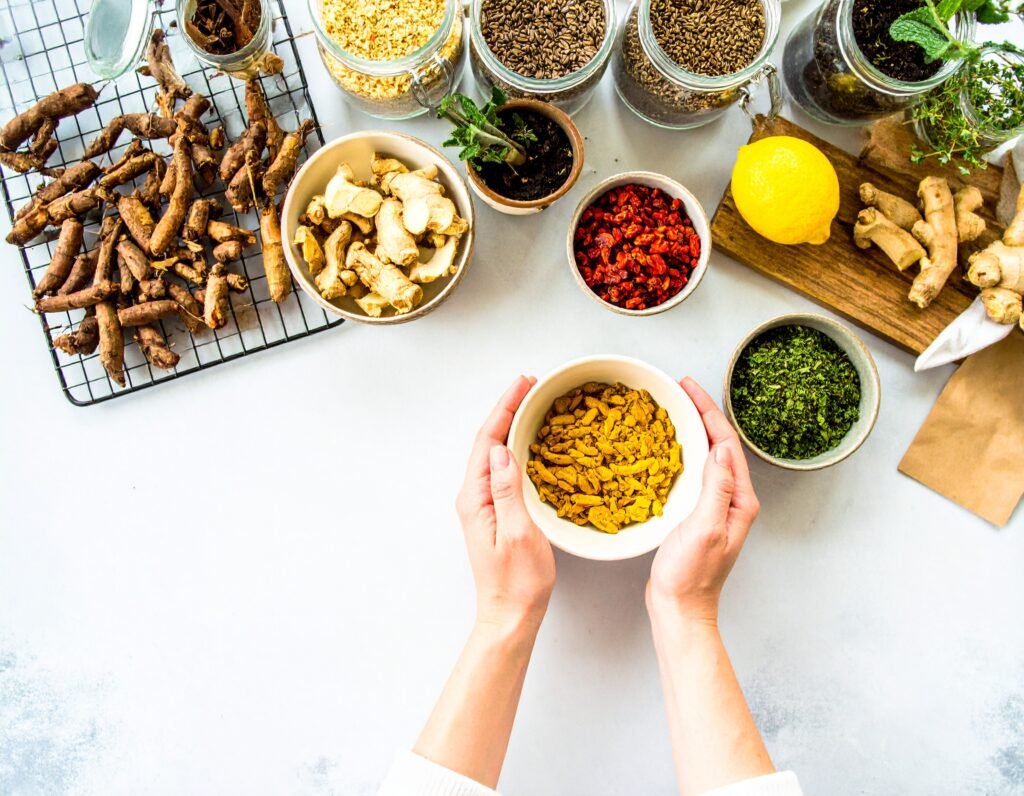Building a Winter Herbal Medicine Cabinet with Ginger, Turmeric, and Ashwagandha

3-Day Gentle Detox Plan
Download your printable checklist— Learn how to use winter roots and adaptogens for immunity and vitality and to Reset your gut—get your gentle 3-day plan now!
Download
Winter brings unique challenges—chill, stress, sluggish immunity, and the need for deeper nourishment. That’s why a home herbal medicine cabinet stocked with warming, strengthening roots like ginger, turmeric, and ashwagandha is essential for cold-weather wellness. In this guide, discover how to source or grow these potent plants, prepare them for everyday use, and create simple, effective remedies to keep you and your family healthy all winter long.

Why Ginger, Turmeric and Ashwagandha Belong in Your Winter Medicine Cabinet
Winter is the season of slower rhythms, colder air, and a greater need for warmth, nourishment, and immune support. Nature provides powerful allies in the form of ginger, turmeric, and ashwagandha—three time-honored herbs that strengthen the body’s natural defenses, restore balance, and promote calm energy. Together, they form a trio of herbal essentials for wellness, comfort, and resilience during the colder months.
Ginger: Warming Circulatory Support
Ginger (Zingiber officinale) is a fiery root that kindles digestion, boosts circulation, and provides instant warmth from the inside out. Its natural compounds, such as gingerols and shogaols, act as anti-inflammatory and anti-nausea agents, helping soothe coughs, calm stomach upset, and ease muscle tension. A simple ginger tea or compress can relieve winter chills, promote sweating during fevers, and support healthy blood flow when cold weather slows the body down.
Turmeric: Anti-Inflammatory Powerhouse
Turmeric (Curcuma longa) is a golden spice revered for its immune-boosting and tissue-healing properties. Its active compound, curcumin, reduces inflammation and supports joint comfort—perfect for soothing winter stiffness, aches, and post-activity soreness. Turmeric also fortifies the liver and digestive system, helping the body process rich, seasonal foods more efficiently. When combined with black pepper or healthy fats, its absorption increases, enhancing both its potency and restorative effects.
Ashwagandha: Adaptogen for Stress & Sleep
Ashwagandha (Withania somnifera) is an adaptogenic root that strengthens the body’s response to stress, fatigue, and emotional strain—making it especially valuable in the darker, slower months of winter. It supports hormonal balance, restful sleep, and immune resilience while gently restoring depleted energy levels. Regular use can calm anxious thoughts, improve focus, and help the body adapt to seasonal changes with steadier vitality.
The Perfect Winter Trio
When used together, ginger, turmeric, and ashwagandha create a synergistic foundation for winter wellness. Ginger kindles warmth and movement, turmeric soothes inflammation and supports healing, and ashwagandha builds endurance and emotional balance. Whether in teas, tonics, or daily supplements, these herbs nourish body and mind through the coldest months of the year.
Quick Tip: Brew a winter wellness tea by combining sliced ginger, turmeric powder, and a pinch of ashwagandha root in hot water. Add lemon and honey for a comforting immune tonic that supports digestion, calm, and steady energy all season long.
Winter Roots for Wellness
- Ginger: A warming, circulatory stimulant that supports digestion, eases nausea, and soothes coughs and colds during chilly months.
- Turmeric: An anti-inflammatory powerhouse that boosts immunity, supports joint health, and helps the body recover from winter aches and inflammation.
- Ashwagandha: A deeply nourishing adaptogenic root that builds stress resilience, promotes restful sleep, balances hormones, and strengthens immune function—especially helpful during the darker, stressful winter season.

Growing or Sourcing Winter Roots
Growing or Sourcing Winter Roots
Ginger, turmeric, and ashwagandha are prized roots that bring warmth, strength, and healing to your winter wellness routine. Whether you cultivate them at home or source them from trusted suppliers, these herbs are surprisingly easy to work with and store for year-round use. Growing your own ensures freshness and potency, while properly dried or powdered roots offer long shelf life and convenience.
Ginger and Turmeric: Easy Indoor Growers
Ginger (Zingiber officinale) and turmeric (Curcuma longa) thrive in warm, humid environments—making them ideal for indoor container gardening during the winter months. Plant small rhizome pieces (with visible buds or “eyes”) in rich, moist, well-draining soil and place in a sunny, warm spot or greenhouse. Keep the soil consistently damp but never soggy.
With regular watering and gentle warmth, shoots will emerge within a few weeks. Harvest ginger or turmeric roots once the leaves begin to yellow, usually after 8–10 months of growth. If space or climate makes growing difficult, you can easily purchase fresh or dried organic roots from natural food stores, co-ops, or herbal suppliers. Fresh roots can be stored in the refrigerator for up to two weeks, or frozen for long-term use.
Ashwagandha: The Adaptogen You Can Grow or Source
Ashwagandha (Withania somnifera) prefers warm, dry climates similar to its native regions in India and the Middle East. In cooler areas, it can be grown in pots indoors or as an annual during warm months. It requires well-drained, sandy soil and full sun. The roots are typically harvested after 5–6 months, once the plant’s leaves begin to yellow.
For those who can’t grow it, high-quality dried root pieces or powders are readily available from herbal suppliers and health stores. Look for organically sourced products from reputable brands to ensure purity and potency.
Preparation and Storage
After harvesting or sourcing your roots, gently wash, slice, and dry them for later use. Drying can be done naturally in a warm, shaded area or with a dehydrator on low heat to preserve active compounds. Once fully dried, store your herbs in airtight glass jars in a cool, dark place to maintain freshness and medicinal strength.
These dried roots can be used to make teas, powders, or tinctures—perfect for winter tonics and daily immune support. Simply grind dried pieces into a fine powder for use in smoothies or lattes, or steep them whole in hot water for a warming, restorative brew.
Quick Tip: Combine homegrown or store-bought ginger, turmeric, and ashwagandha roots to create a winter wellness blend that supports immunity, digestion, and calm energy all season long.
MoveWell Daily: Plant & Nutrient Powered Joint Formula
- Features Turmeric Curcumin, Boswellia Serrata, Type II Collagen, Hyaluronic Acid
- Traditional botanicals plus modern joint nutrients
- No harsh chemicals—just science-backed natural relief


Easy Remedies for Winter Wellness
Winter invites us to slow down, nourish deeply, and strengthen our natural defenses. With a few simple ingredients—ginger, turmeric, and ashwagandha—you can create comforting, healing remedies that warm the body, calm the mind, and support immunity. These time-honored blends are easy to make at home and help restore balance through the colder months.
Ginger–Turmeric Tea
A classic winter remedy that combines the warming, digestive power of ginger with the anti-inflammatory strength of turmeric. This tea supports immunity, circulation, and respiratory health while easing cold-weather stiffness.
How to make: Simmer fresh slices of ginger and turmeric in water for 10–20 minutes. Strain, then add honey and lemon to taste. Sip throughout the day to stay warm, energized, and protected against seasonal bugs.
Golden Milk
This soothing bedtime drink blends turmeric, ginger, and ashwagandha into a creamy tonic that relaxes the body and restores vitality. Perfect for winding down on cold nights or supporting recovery after long days.
How to make: Warm milk (dairy or plant-based) in a small pot, then whisk in turmeric, grated ginger, and 1 teaspoon of ashwagandha powder. Sweeten with honey and a pinch of black pepper for enhanced absorption. Drink before bed for deep relaxation and immune support.
Adaptogen Honey
A simple yet potent way to harness the synergy of these herbs daily. Adaptogen honey blends the resilience of ashwagandha with the warming energy of ginger and turmeric.
How to make: Stir equal parts powdered ashwagandha, ginger, and turmeric into raw honey until smooth. Take a teaspoon daily on its own or stir into warm teas for a sweet immune and stress-supporting boost.
Stress-Busting Bedtime Tea
This calming herbal blend eases tension, supports restful sleep, and replenishes the nervous system after long, chilly days. The ashwagandha soothes stress, chamomile calms the mind, and cinnamon adds warmth and circulation.
How to make: Steep dried ashwagandha root with chamomile flowers and a cinnamon stick in hot water for 10–15 minutes. Strain and enjoy before bed for a cozy, grounding ritual that helps you drift into restorative sleep.
Quick Tip: Keep a small batch of dried roots or adaptogen honey on hand—these easy remedies help you stay balanced, strong, and centered all winter long.
This herbal recipe is shared for educational purposes only, based on traditional use and available sources. It is not medical advice. Please consult your healthcare provider before use, especially if pregnant, nursing, or on medication.
Insta Soothe: Capsaicin, Arnica & Turmeric Relief Cream
- Features plant-powered actives: Capsaicin, Arnica, Turmeric, Boswellia Serrata
- Menthol and MSM for soothing coolness and mobility
- No harsh chemicals—just natural comfort for your joints
Winter Roots Kit + 3-Day Gentle Detox Plan
Ready to build your herbal medicine cabinet? Download our winter guide and shop our top kit for immune and stress support.
Download Free PDF Guide Shop Roots at AmazonDisclosure:We may earn from qualifying purchases.

Did You Know?
Ready to Build Your Winter Herbal Medicine Cabinet?
Subscribe
Subscribe to Health Intel Daily for more step-by-step herbal guides, winter wellness tips, and restorative recipes delivered right to your inbox!